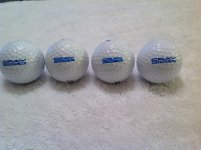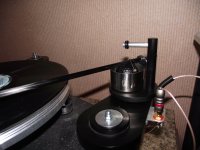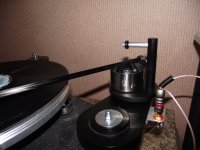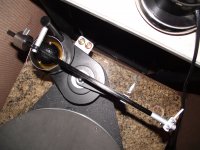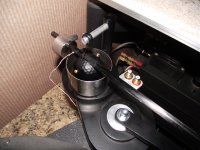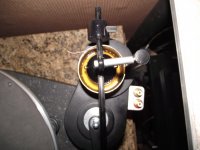Very nice work. Do you make the oil tank and the ball hanger yourself? I can't imagine you can buy them off the shelves? If they are available off the shelve, I may try to make one using wood wand.
Well Tempered Clone
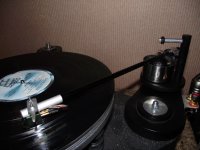

Hello Everyone
Here are pictures of my latest version of the WT arm. I've been building these for over a year now and I have to say, it's the easiest arm in the world to get good results from. This one took around 2-3 hours to build!
How does it sound? Is it better than the others I have constructed? I'm getting to a stage now where there is a base line of excellent performance and each model I make sounds 'different' in one way or another-no better/no worse!
This one has a carbon fibre tube, filled with fine sand as the Bill F. one does. Next one will be using an arrow shaft. I've become a big fan of the arrow shaft after building a few of Nanook's arms. Thanks to Stew for this-Also I understand that you are contemplating building a WT clone, Stew. Have a go-couldn't be more simple.
Watch this space for more ideas and iterations
Chris G


Hello Everyone
Here are pictures of my latest version of the WT arm. I've been building these for over a year now and I have to say, it's the easiest arm in the world to get good results from. This one took around 2-3 hours to build!
How does it sound? Is it better than the others I have constructed? I'm getting to a stage now where there is a base line of excellent performance and each model I make sounds 'different' in one way or another-no better/no worse!
This one has a carbon fibre tube, filled with fine sand as the Bill F. one does. Next one will be using an arrow shaft. I've become a big fan of the arrow shaft after building a few of Nanook's arms. Thanks to Stew for this-Also I understand that you are contemplating building a WT clone, Stew. Have a go-couldn't be more simple.
Watch this space for more ideas and iterations
Chris G
Attachments
Nice work Chris. May I ask where you sourced the "well" that holds the damping fluid? I have one of Stew's arms here that I want to give the "WT" treatment.
jeff
jeff
Hi
It's a stainless steel toothbrush holder cut down-just the right diameter for the golf ball-cost £1.96 from Asda (Wal-mart). Looks good too
Love it.
 You're right, it does look good.
You're right, it does look good.jeff
Nice job Chris,
Are those two slotted brass screws holding the mono filament in place ?
Is the arm base a cam on a pivoting second base, to get the extra distance from, say a standard fixing hole ?
I have a ball, an arm tube, & a pillar. so gathering as much info as needed before starting my own WTA over the winter.
Jay
Are those two slotted brass screws holding the mono filament in place ?
Is the arm base a cam on a pivoting second base, to get the extra distance from, say a standard fixing hole ?
I have a ball, an arm tube, & a pillar. so gathering as much info as needed before starting my own WTA over the winter.
Jay
Hi Jay
There is a single bolt under the base to mount the arm-it's off-centre to allow adjustment to be made. The fixtures for the monofilament are brass screws. Next stage is to use an aluminium arrow shaft instead of carbon fibre. I'm also going to experiment with fluids of different viscosity. Anyone out there know what WT Labs actually use? I'm convinced that this is a real improvement on all other arms I have tried or made.
This is one great arm!!
There is a single bolt under the base to mount the arm-it's off-centre to allow adjustment to be made. The fixtures for the monofilament are brass screws. Next stage is to use an aluminium arrow shaft instead of carbon fibre. I'm also going to experiment with fluids of different viscosity. Anyone out there know what WT Labs actually use? I'm convinced that this is a real improvement on all other arms I have tried or made.
This is one great arm!!
Hi Jay
There is a single bolt under the base to mount the arm-it's off-centre to allow adjustment to be made. The fixtures for the monofilament are brass screws. Next stage is to use an aluminium arrow shaft instead of carbon fibre. I'm also going to experiment with fluids of different viscosity. Anyone out there know what WT Labs actually use? I'm convinced that this is a real improvement on all other arms I have tried or made.
This is one great arm!!
Hi Chris,
It has been ~20 years since I built my WTA so the memory is a bit foggy, but I think it was 10,000 CS. The commercial WTA took about 9 to 10 seconds to descend from 1.5" maybe 2" to the record surface. Great fun to watch. I got 4 different samples from Dow Corning and tried them all. The one that duplicated that drop time was the one I used. Later I will look for the can, read the label and get back to you. If you have access to a real live WTA, golf ball type, try the drop test. The silicone fluid at 10,000 CS is thick stuff. My arm was a pretty close copy of the real, original model.
Rgds,
BillG
Hi Bill,
I've read a fair bit about WTArms & I think you'r the first one thats mentioned this 'slow decent' !!
Chris,
I have half an Eastman X75 about 15" long, left from making the '219' It will be my shaft of choice lol.
Theres number of different ways to mount the Cart so will consider some of the various options.
First thing to consider is the height of the Cart compared to the tube. e.g. above or below
This will have a bearing on the type of Cart fixing.....
Anyone have opinions as to what BEST practice might be ?
jay
I've read a fair bit about WTArms & I think you'r the first one thats mentioned this 'slow decent' !!
Chris,
I have half an Eastman X75 about 15" long, left from making the '219' It will be my shaft of choice lol.
Theres number of different ways to mount the Cart so will consider some of the various options.
First thing to consider is the height of the Cart compared to the tube. e.g. above or below
This will have a bearing on the type of Cart fixing.....
Anyone have opinions as to what BEST practice might be ?
jay
Hi Jay
Look at my method of making a headshell. I prefer this, Stew likes wood. I've tried both and have plumped for my current design. Very similar to the Clearaudio and Morch fixings-and-as the fingerlift and mounting bracket are all in one piece it makes getting the offset angle correct a real doddle. It is inert (doesn't ring) due to the filling of epoxy putty-makes it very rigid too.And I think it looks a lot neater than a piece of wood.
Chris
Look at my method of making a headshell. I prefer this, Stew likes wood. I've tried both and have plumped for my current design. Very similar to the Clearaudio and Morch fixings-and-as the fingerlift and mounting bracket are all in one piece it makes getting the offset angle correct a real doddle. It is inert (doesn't ring) due to the filling of epoxy putty-makes it very rigid too.And I think it looks a lot neater than a piece of wood.
Chris
Ok will have a look.
If you look back at my earlier posts you'll see my wooden head shell, it not only looks good but works well, though I will admit it is bit heavy.....
so am looking for more light weight solution.
Jay
If you look back at my earlier posts you'll see my wooden head shell, it not only looks good but works well, though I will admit it is bit heavy.....
so am looking for more light weight solution.
Jay
Question about use of such a thick liquid .....
If the silicone liquid is thick enough that it the arm takes 10+ seconds to drop from horizontal to the record surface, would that not also cause issues with lateral movement? Namely in the cartridge movement as it tracks across the album, would that not cause too much "friction" for the arm to move freely?
I am likening it to trying to walk through molasses. Granted it would pretty much eliminate skating......
If the silicone liquid is thick enough that it the arm takes 10+ seconds to drop from horizontal to the record surface, would that not also cause issues with lateral movement? Namely in the cartridge movement as it tracks across the album, would that not cause too much "friction" for the arm to move freely?
I am likening it to trying to walk through molasses. Granted it would pretty much eliminate skating......
Question about use of such a thick liquid .....
If the silicone liquid is thick enough that it the arm takes 10+ seconds to drop from horizontal to the record surface, would that not also cause issues with lateral movement? Namely in the cartridge movement as it tracks across the album, would that not cause too much "friction" for the arm to move freely?
I am likening it to trying to walk through molasses. Granted it would pretty much eliminate skating......
The simple analogy is, as in walking through molasses the faster you walk, the harder you push the more difficult it becomes to move. I found that at the rate of traverse from one groove to the next there was no detectable impeding of the motion. The arm did easily track horizontally and vertically.
Because of the difference in shape and surface area pushing on the fluid there may be a difference between the golf ball and the original component, a disk about 1/8" thick and about 1 1/8" in diameter. It had some holes in it to adjust the drag. The golf ball could require a lighter or a heavier viscosity. Got to try it.
BillG
Where is the best place to buy the silicone and how much is actually needed to support? the golf ball.
I'd like to know as well.
I've heard that remote control cars use some sort of fluid that can be used !
Though really not sure
Jay
I've heard that remote control cars use some sort of fluid that can be used !
Though really not sure
Jay
Hi guys...
In preparation to trying my hand at a WTL type tonearm a few years ago, I bought some of this: Team Associated shock fluid. I'm unsure if it is the correct weight (this is the 10 wt) , but they have it in various weights. Now in the UK or Europe, I don't know where one might get that, but I'm sure there would be similar from perhaps brands that I am unaware of. It could be that this is just re-bottled and packaged fluid, but Associated states it is made (in the U.S.) by Lucas Oil Products,who make many additives, lubricants and fluids for high performance (full sized) vehicles.
Now just gotta find a golf ball, a couple of screws, bah, blah, blah. I've got the stuff to make one of these, I'm just being stubborn.
In preparation to trying my hand at a WTL type tonearm a few years ago, I bought some of this: Team Associated shock fluid. I'm unsure if it is the correct weight (this is the 10 wt) , but they have it in various weights. Now in the UK or Europe, I don't know where one might get that, but I'm sure there would be similar from perhaps brands that I am unaware of. It could be that this is just re-bottled and packaged fluid, but Associated states it is made (in the U.S.) by Lucas Oil Products,who make many additives, lubricants and fluids for high performance (full sized) vehicles.
Now just gotta find a golf ball, a couple of screws, bah, blah, blah. I've got the stuff to make one of these, I'm just being stubborn.
Where is the best place to buy the silicone and how much is actually needed to support? the golf ball.
Please note that the golf ball and tone arm wand with cartridge isn't supported by the fluid. It isn't floating, it is sinking. The support comes from the strings attached to the ball. The strings are tight and they twist and untwist with the rotation of the arm. This twisting supplies torque to the rotating ball. The amount of torque is determined both by the amount of twist and the weight of the arm assembly as well as the viscosity of the fluid.
Be careful that you do not have increasing torque as the arm moves to the center of the record. The normal reduction of skating force as the cartridge moves inward calls for a reduction of antiskating force. It is easy to set the WTA up to apply antiskating force in the wrong direction. Lots of arms get this wrong.
Good luck,
BillG
Thanks guys I have found some fluid suppliers in the UK and I'll twist the father in laws arm to part with a couple of golf balls😉
Bill I had realised that the ball wasn't supported as such by the silicone but thanks for the hints regarding the thread twist for the anti skating.
Bill I had realised that the ball wasn't supported as such by the silicone but thanks for the hints regarding the thread twist for the anti skating.
- Status
- Not open for further replies.
- Home
- Source & Line
- Analogue Source
- My DIY WTL Tonearm
